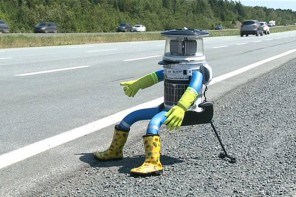Regardless of what happens with the current outbreak of swine flu, 2009 will go down in the books as a plague year. Even though the disease has nothing to do with the economy or the wrenching debate over health care reform, it has arrived at a perfect time to match our collective sense of uncertainty about our financial, emotional, and physical well-being.
It is only fitting that Peter Christian Hall’s online novel American Fever: A Tale of Romance and Pestilence, should appear now, during this season for fear. The premise is simple: The narrator sells flu protection gear (masks, goggles, disinfectant) out of his Lower East Side apartment as a deadly H5N1 pandemic washes over the city, causing massive casualties and wreaking havoc to the social fabric. Better equipped and informed than the vast of majority of his fellow New Yorkers, the narrator composes a blog that chronicles his city’s struggles and wins an international following.
The novel contains several plotlines, including the narrator’s own difficulties in forging personal relationships, his need for and fear of social isolation, and the impromptu groups that emerge to care for victims of the crisis. But what makes American Fever compelling is that way that Hall has insinuated the novel within existing networks of information about viruses and the history of disease. The novel is laden with discussion of previous pandemics and epidemics (including the swine flu outbreak that, in the universe of American Fever, preceded the more deadly H5N1). It is also deeply enmeshed within the networks of flublogia: real bloggers with a variety of professional backgrounds who track the progression of influenza viruses and research throughout the globe.
The Danger of Human Contact
Priscilla Wald, a literature professor at Duke, has written on what she calls the “outbreak narrative,” stories of disease in popular culture. As she explains, these stories always take on the social anxieties of their moment—from the anti-immigrant sentiment that surrounded Typhoid Mary to the contemporary concerns of globalization. The emergence of disease, she writes, “dramatizes the dilemma that inspires the most basic of human narratives: the necessity and danger of human contact.”
Stories of disease are also frequently stories of the divine. Wald reminds us that in works like The Iliad and Oedipus Rex, “plagues are the language of the gods’ displeasure.” There, transgressions of the divine unleash deadly contagion, a mytheme that would be grafted onto the scientific storyscape in the twentieth century. Our contemporary version of this narrative element is the sense that we have brought these viruses upon ourselves through environmental degradation—that we have violated the earth and it is now taking its revenge.
In American Fever, Hall’s narrator explains how these religious and secular apocalyptic visions dovetail. Evangelical Christians look to each new disaster, he writes, for signs of Judgment Day; Muslims look for the return of Christ as an Islamic prophet; and “eco-doomsayers assert that their own exciting views of catastrophe are rooted in science and measurable observation.” But our survivalist is not having it. He’s skeptical of grand theories to explain the pandemic, just as he’s wary of anyone who claims to know how to combat it. In fact, one of the themes that emerges from his forays into the world of flu scholarship is how little we actually know about the way that viruses work.
Outbreak narratives typically have villains and heroes: the carrier who unwittingly infects unsuspecting masses, the scientist who doggedly investigates the disease and presses for an antidote. But Hall’s narrator is different. He has moments of unselfishness, but much of the time he seals himself in his room to dig into the lore of the viral threat. He provides survival equipment, but he sells it—and one recurring thread of the novel is his defense of that enterprise. One of the clever features of the Web site, in fact, is that one can in fact purchase “personal protection gear” via links to Amazon.
Disease, the Internet, and Cultural Anxiety
If there’s a hero in American Fever, it might be, in fact, the Internet itself. Technology does not, as in other stories of scientific heroism, create a cure for the virus. Instead, the Internet is what allows the narrator to manage his survival, both through his writing and through his business. It is also what creates the experience of the novel. Though Hall plans to publish American Fever in book form after its conclusion, I don’t think the experience of reading it in print will be as rich as reading it on the screen. Much of what makes American Fever tick is in the way that it can blur the fictional and real words of fear and illness. With its careful documentation and heavy use of hyperlinks, American Fever does not easily disclose which information about disease is true and which is not, and uncertainty sits at the core of the cultural anxiety it maps.
The Manhattan setting of American Fever is the thickest example we have in the United States of a heterogeneous community compacted into a bounded physical space; a place of face-to-face interaction and networks. The novel is not simply about what happens to that community in a time of intense crisis, but what happens to that community in the age of the Internet. Perhaps a better title for it might have been “Love and Death in the Time of Facebook.” It’s a new era, but with some very old worries.



